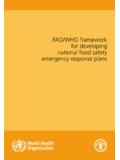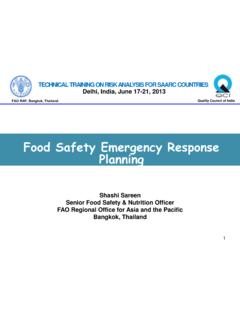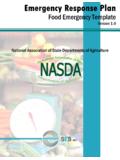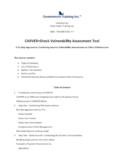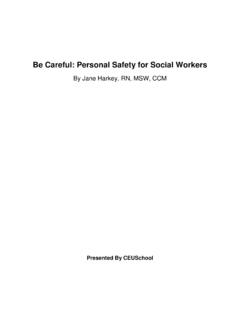Transcription of CHAPTER 6 THE ROLE OF THE PRIVATE SECTOR IN …
1 This CHAPTER will appear in the second edition of Homeland Security and emergency Management: A Legal Guide for State and Local Governments, edited by Ernest B. Abbott and Otto J. Hetzel, due out in spring 2010. CHAPTER 6 THE ROLE OF THE PRIVATE SECTOR IN emergency PREPAREDNESS, PLANNING, AND response By Evan Wolff and George Koenig [T]he PRIVATE SECTOR controls 85 percent of the critical infrastructure in the nation. Indeed, unless a terrorist's target is a military or other secure government facility, the "first" first responders will almost certainly be civilians. Homeland security and national preparedness therefore often begins with the PRIVATE SECTOR .. PRIVATE - SECTOR preparedness is not a luxury; it is a cost of doing business in the post-9/11 9/11 Commission Report (emphasis added) I.
2 Introduction The PRIVATE SECTOR is likely to be the first line of defense against the next man-made or natural disaster. Any government planning or response that does not adequately account for the PRIVATE SECTOR s role in any response or recovery is doomed to fail. This should come as no surprise to all who have witnessed numerous large scale disasters that have struck the United States in the last several decades whether it is a terrorist attack, a hurricane, an earthquake, a flood, fire, etc. The PRIVATE SECTOR s role in disaster planning and response is so essential because it owns and operates the overwhelming majority of the national , state, and local critical infrastructure and key resources.
3 This CHAPTER will focus on the vital role of the PRIVATE SECTOR in emergency planning, preparedness and response . As will be discussed below, successful government/ PRIVATE SECTOR collaboration requires an understanding of the following: (i) critical infrastructure protection (CIP)2 - including key federal planning directives, documents, legislation, and regulations; and 1 THE NAT L COMMISSION ON TERRORISTS ATTACKS UPON THE , THE 9/11 COMMISSION REPORT (2004) (hereinafter The 9/11 Commission Report ), p. 398; 2 The authors acknowledge the challenge of learning the homeland security lexicon and apologize in advance for the heavy use of acronyms.
4 For each key acronym we use, we will define it in the body of the CHAPTER , but for ease of reference, the following is a summary of key acronyms: ANAB ANSI-ASQ national Accreditation Board ANSI American national Standards Institute BCP Business Continuity Plan CFATS Chemical Facility Anti-Terrorism Standards Wolff and Koenig, The Role of the PRIVATE SECTOR in emergency Planning, Preparedness, and response Forthcoming in Homeland Security and emergency Management, 2d ed. (ABA 2010) - 2 - (ii) individual and PRIVATE SECTOR preparedness (including business continuity planning).
5 Ultimately, a successful response to the next disaster will depend upon all the work that was done by individuals, companies, communities and government at all levels before the event happens. II. Critical Infrastructure Protection (CIP) Our nation s financial, physical, and cyber security depends on the effective functioning of its critical infrastructures. Congress defines critical infrastructures as the: systems and assets, whether physical or virtual, so vital to the United States that the incapacity or destruction of such systems and assets would have a debilitating CII Critical Infrastructure Information CIKR Critical Infrastructures and Key Resources CIP Critical Infrastructure Protection CIPAC Critical Infrastructure Partnership Advisory Council CUI Controlled Unclassified Information CVI Chemical Vulnerability Information DHS Department of Homeland Security FEMA Federal emergency Management Agency FOIA Freedom of Information Act HITRAC Homeland
6 Infrastructure Threat and Risk Analysis Center HSA Homeland Security Act of 2002 HSAS Homeland Security Advisory System HSPD-7 Homeland Security Presidential Directive-7 IRTPA Intelligence Reform and Terrorism Prevention Act of 2004 ISACs Information Sharing and Analysis Centers ISE Information Sharing Environment NFPA 1600 national Fire Protection Association Standard 1600 NIAC national Infrastructure Advisory Council NIMS national Incident Management System NIPC national Infrastructure Protection Center NIPP national Infrastructure Protection Plan NPPD national Protection and Programs Directorate NRF national response Framework NRP national response Plan OHS White House Office of Homeland Security PCII Protected Critical Infrastructure Information PDD-63 Presidential Decision Directive 63 PSO PRIVATE SECTOR Office PS-Prep Voluntary PRIVATE SECTOR Preparedness Accreditation and Certification Program QHSR Quadrennial Homeland Security Review SSAs SECTOR -Specific Agencies SSI Sensitive Security Information SSPs SECTOR -Specific Plans SVAs Security Vulnerability Assessments TRIA Terrorism
7 Risk Insurance Act Wolff and Koenig, The Role of the PRIVATE SECTOR in emergency Planning, Preparedness, and response Forthcoming in Homeland Security and emergency Management, 2d ed. (ABA 2010) - 3 - impact on security, national economic security, national public health or safety , or any combination of those matters. 3 What makes certain systems and assets critical is almost self-evident. For instance, it is inconceivable that our country could function without: power plants; a safe and abundant food supply; hospitals and emergency rooms; automobile, rail and air transportation systems; financial networks (including ATMs, credit cards, etc.)
8 , telecommunications, and the internet. It is through the functioning of critical infrastructures that the PRIVATE SECTOR provides the goods and services that make our way of life possible. Critical infrastructures, by definition, are often interdependent; there is a substantial risk that a decrease in capacity in one critical infrastructure SECTOR may have a catastrophic, cascading effect in another SECTOR regardless of region or locality. This notion of interdependence really strikes at the heart of the concept of critical infrastructure simply because your home, business, facility, region, or industry was not directly attacked, destroyed, or damaged by a disaster does not mean that you will not be severely impacted.
9 For example, if a power plant is damaged or destroyed by a hurricane or tornado, it would adversely impact the region s electrical supply. A reduced supply of electricity could impact numerous industries that might not otherwise have been damaged; for example: (i) banking ATMs might be shut down; (ii) transportation -- rail cars powered by electricity might not be able to transport commuters to and from work. Another example is a cyber-attack that cripples the internet. We have become so dependent on the internet that such an attack could dramatically impact commerce across the United States; for instance, if a cyber attack was severe and debilitating enough, businesses would need to receive orders by slower, older-fashioned methods ( , mail, fax, etc.)
10 ; fast and simple email communications would not be possible; documents could not be easily exchanged and edited. And the list goes on. As will be discussed below, because the overwhelming majority of critical infrastructures are privately owned, any effort to protect them and our nation requires collaboration and support from the PRIVATE SECTOR . Protecting the nation s critical infrastructure, has taken an evolutionary path involving executive branch direction and coordination, congressional action and oversight, agency regulation, federal programs, PRIVATE - SECTOR outreach, and information sharing. A seminal document in this area is the national Infrastructure Protection Plan (NIPP), which established the vernacular and process for organizing governments and the PRIVATE SECTOR in a unified direction in order to more urgently address the task of CIP.
